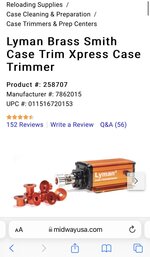- Messages
- 9,364
- Reactions
- 23,649
I use a Lee trimmer for all my cartridges except the Snider. One gauge per calibre and one cutter that does them all, including .45-70 Govt [where necessary]. The shell holder goes in a little screwdriver/drill I bought from Walmart - the gauge goes into the neck of the case and hits the shell-holder through the primer hole. If it doesn't, then you trim it until it does and when it stops cutting then there is no more to cut. THEN, leaving the case in place, you can deburr inside and out.
Can't get much easier than that.
Can't get much easier than that.













